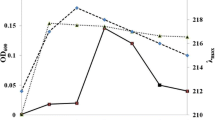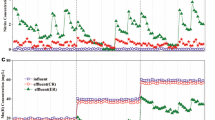Abstract
Novel poly(3-hydroxybutyrate-co-3-hydroxyvalerate) (PHBHV) copolymers produced by haloarchaea are excellent candidate biomaterials. However, there is no report hitherto focusing on the biodegradation of PHBHV synthesized by haloarchaea. In this study, an environmental biodegradation of haloarchaea-produced PHBHV films, with 10~60 mol% 3-hydroxyvalerate (3HV) composition and different microchemical structures, was studied in nutrition-depleted activated sludge. The changes in mass, molar mass, chemical composition, thermal properties, and surface morphology were monitored. The mass and molar mass of each film decreased significantly, while the PHA monomer composition remained unchanged with time. Interestingly, the sample of random copolymer PHBHV-2 (R-PHBHV-2) (3HV, 30 mol%) had the lowest crystallinity and was degraded faster than R-PHBHV-3 containing the highest 3HV content or the higher-order copolymer PHBHV-1 (O-PHBHV-1) possessing the highest surface roughness. The order of biodegradation rate was in the opposite trend to the degree of crystallizability of the films. Meanwhile, thermal degradation temperature of most films decreased after biodegradation. Additionally, the surface erosion of films was confirmed by scanning electron microscopy. The dominant bacteria probably responsible for the degradation process were identified in the activated sludge. It was inferred that the degradation rate of haloarchaea-produced PHBHV films mainly depended on sample crystallinity, which was determined by monomer composition and microchemical structure and in turn strongly influenced surface morphology.






Similar content being viewed by others
Change history
08 January 2018
The published online version contains mistake in the funding information. Instead of 30370096, it should have been 31370096.
References
Arcos-Hernandez MV, Laycock B, Pratt S, Donose BC, Nikolić MA, Luckman P, Werker A, Lant PA (2012) Biodegradation in a soil environment of activated sludge derived polyhydroxyalkanoate (PHBV). Polym Degrad Stabil 97:2301–2312. doi:10.1016/j.polymdegradstab.2012.07.035
Bloembergen S, Holden DA, Hamer GK, Bluhm TL, Marchessault RH (1986) Studies of composition and crystallinity of bacterial poly(beta-hydroxybutyrate-co-beta-hydroxyvalerate). Macromolecules 19:2865–2871. doi:10.1021/ma00165a034
Bluhm TL, Hamer GK, Marchessault RH, Fyfe CA, Veregin RP (1986) Isodimorphism in bacterial poly(beta-hydroxybutyrate-co-beta-hydroxyvalerate). Macromolecules 19:2871–2876. doi:10.1021/ma00165a035
Boyandin AN, Prudnikova SV, Karpov VA, Ivonin VN, Đỗ NL, Nguyễn TH, Lê TMH, Filichev NL, Levin AL, Filipenko ML, Volova TG, Gitelson II (2013) Microbial degradation of polyhydroxyalkanoates in tropical soils. Int Biodeter Biodegr 83:77–84. doi:10.1016/j.ibiod.2013.04.014
Choi GG, Kim HW, Rhee YH (2004) Enzymatic and non-enzymatic degradation of poly (3-hydroxybutyrate-co-3-hydroxyvalerate) copolyesters produced by Alcaligenes sp. MT-16. J Microbiol 42:346–352
Doi Y, Kanesawa Y, Kunioka M, Saito T (1990) Biodegradation of microbial copolyesters: poly (3-hydroxybutyrate-co-3-hydroxyvalerate) and poly (3-hydroxybutyrate-co-4-hydroxybutyrate). Macromolecules 23:26–31. doi:10.1021/ma00203a006
Doi Y, Kumagai Y, Tanahashi N, Mukai K (1992) Structural effect on biodegradation of microbial and synthetic poly(hydroxyalkanoates). In: Vert M, Feijen J, Albertsson A, Scott G, Chiellini E (eds) Biodegradable polymers and plastics. The Royal Society of Chemistry, Cambridge
Freier T, Kunze C, Nischan C, Kramer S, Sternberg K, Sass M, Hopt UT, Schmitz KP (2002) In vitro and in vivo degradation studies for development of a biodegradable patch based on poly(3-hydroxybutyrate). Biomaterials 23:2649–2657. doi:10.1021/ma00203a006
Han J, Hou J, Liu H, Cai S, Feng B, Zhou J, Xiang H (2010) Wide distribution among halophilic archaea of a novel polyhydroxyalkanoate synthase subtype with homology to bacterial type III synthases. Appl Environ Microbiol 76:7811–7819. doi:10.1128/AEM.01117-10
Han J, Lu Q, Zhou L, Zhou J, Xiang H (2007) Molecular characterization of the phaEC Hm genes, required for biosynthesis of poly(3-hydroxybutyrate) in the extremely halophilic archaeon Haloarcula marismortui. Appl Environ Microbiol 73:6058–6065. doi:10.1128/AEM.00953-07
Han J, Wu LP, Hou J, Zhao D, Xiang H (2015) Biosynthesis, characterization, and hemostasis potential of tailor-made poly(3-hydroxybutyrate-co-3-hydroxyvalerate) produced by Haloferax mediterranei. Biomacromolecules 16:578–588. doi:10.1021/bm5016267
Holland SJ, Jolly AM, Yasin M, Tighe BJ (1987) Polymers for biodegradable medical devices. II Hydroxybutyrate-hydroxyvalerate copolymers: hydrolytic degradation studies. Biomaterials 8:289–295. doi:10.1016/0142-9612(87)90117-7
Imam SH, Gordon SH, Shorgen RL, Toseson TR, Govind NS, Greene RV (1999) Degradation of starch poly(β-hydroxybutyrate-co-β-hydroxyvalerate) bioplastic in tropical coastal waters. Appl Environ Microbiol 65:431–437
Jendrossek D, Handrick R (2002) Microbial degradation of polyhydroxyalkanoates*. Annu Rev Microbiol 56:403–432. doi:10.1146/annurev.micro.56.012302.160838
Jin H, Nikolau BJ (2012) Role of genetic redundancy in polyhydroxyalkanoate (PHA) polymerases in PHA biosynthesis in Rhodospirillum rubrum. J Bacteriol 194:5522–5529. doi:10.1128/JB.01111-12
Kobayashi T, Nishikori K, Saito T (2004) Properties of an intracellular poly (3-hydroxybutyrate) depolymerase (PhaZ1) from Rhodobacter spheroides. Curr Microbiol 49:199–202. doi:10.1007/s00284-004-4339-y
Koller M, Hesse P, Bona R, Kutschera C, Atlic A, Braunegg G (2007) Potential of various archae- and eubacterial strains as industrial polyhydroxyalkanoate producers from whey. Macromol Biosci 7:218–226. doi:10.1002/mabi.200600211
Koller M (2015) Recycling of waste streams of the biotechnological poly(hydroxyalkanoate) production by Haloferax mediterranei on whey. Int J Polym Sci 2015:370164
Liu GM, Hou J, Cai SF, Zhao DH, Cai L, Han J, Zhou J, Xiang H (2015) A patatin-like protein associated with the polyhydroxyalkanoate (PHA) granules of Haloferax mediterranei acts as an efficient depolymerase in the degradation of native PHA. Appl Environ Microbiol 81:3029–3038. doi:10.1128/Aem.04269-14
Liu H, Pancholi M, Stubbs J, Raghavan D (2010) Influence of hydroxyvalerate composition of polyhydroxy butyrate valerate (PHBV) copolymer on bone cell viability and in vitro degradation. J Appl Polym Sci 116:3225–3231. doi:10.1002/app.31915
Lopez-Llorca L, Valiente MC, Gascon A (1993) A study of biodegradation of poly-β-hydroxyalkanoate (PHA) films in soil using scanning electron microscopy. Micron 24(1):23–29. doi:10.1016/0968-4328(93)90012-P
Marchesault RH, Monasterios CJ, Jesudason JJ, Ramsay B, Saracovan I, Ramsay J, Saito T (1994) Chemical, enzymatic and microbial-degradation of bacterial and synthetic poly-beta-hydroxyalkanoates. Polym Degrad Stabil 45:187–196. doi:10.1016/0141-3910(94)90136-8
Miller ND, Williams DF (1987) On the biodegradation of poly-beta-hydroxybutyrate (PHB) homopolymer and poly-beta-hydroxybutyrate-hydroxyvalerate copolymers. Biomaterials 8:129–137. doi:10.1016/0142-9612(87)90102-5
Molitoris H, Moss S, De Koning G, Jendrossek D (1996) Scanning electron microscopy of polyhydroxyalkanoate degradation by bacteria. Appl Microbiol Biotechnol 46:570–579
Ou WF, Qiu HD, Chen ZF, Xu KT (2011) Biodegradable block poly(ester-urethane)s based on poly(3-hydroxybutyrate-co-4-hydroxybutyrate) copolymers. Biomaterials 32:3178–3188. doi:10.1016/j.biomaterials.2011.01.031
Phukon P, Saikia JP, Konwar BK (2012) Bio-plastic (P-3HB-co-3HV) from Bacillus circulans (MTCC 8167) and its biodegradation. Colloid Surface B 92:30–34. doi:10.1016/j.colsurfb.2011.11.011
Russell JR, Huang J, Anand P, Kucera K, Sandoval AG, Dantzler KW, Hickman D, Jee J, Kimovec FM, Koppstein D, Marks DH, Mittermiller PA, Nunez SJ, Santiago M, Townes MA, Vishnevetsky M, Williams NE, Vargas MP, Boulanger LA, Bascom-Slack C, Strobel SA (2011) Biodegradation of polyester polyurethane by endophytic fungi. Appl Environ Microbiol 77:6076–6084. doi:10.1128/AEM.00521-11
Schober U, Thiel C, Jendrossek D (2000) Poly(3-hydroxyvalerate) depolymerase of Pseudomonas lemoignei. Appl Environ Microbiol 66:1385–1392. doi:10.1128/AEM.66.4.1385-1392.2000
Shinohe T, Nojiri M, Saito T, Stanislawski T, Jendrossek D (1996) Determination of the active sites serine of the poly(3-hydroxybutyrate) depolymerases of Pseudomonas lemoignei (PhaZ5) and of Alcaligenes faecalis. FEMS Microbiol Lett 141:103–109. doi:10.1016/0378-1097(96)00210-8
Spyros A, Kimmich R, Briese B, Jendrossek D (1997) 1H NMR imaging study of enzymatic degradation in poly(3-hydroxybutyrate) and poly(3-hydroxybutyrate-co-3-hydroxyvalerate). Evidence for preferential degradation of the amorphous phase by PHB depolymerase B from Pseudomonas lemoignei. Macromolecules 30:8218–8225. doi:10.1021/ma971193m
Tomasi G, Scandola M, Briese B, Jendrossek D (1996) Enzymatic degradation of bacterial poly(3-hydroxybutyrate) by a depolymerase from Pseudomonas lemoignei. Macromolecules 29:507–513. doi:10.1021/ma951067n
Wang Y, Yin J, Chen GQ (2014) Polyhydroxyalkanoates, challenges and opportunities. Curr Opin Biotechnol 30:59–65. doi:10.1016/j.copbio.2014.06.001
Wang YW, Mo WK, Yao HL, Wu Q, Chen JC, Chen GQ (2004) Biodegradation studies of poly(3-hydroxybutyrate-co-3-hydroxyhexanoate). Polym Degrad Stabil 85:815–821. doi:10.1016/j.polymdegradstab.2004.02.010
Wilcox C, Van Sebille E, Hardesty BD (2015) Threat of plastic pollution to seabirds is global, pervasive, and increasing. Proc Natl Acad Sci U S A 112:11899–11904. doi:10.1073/pnas.1502108112
Xu XY, Li XT, Peng SW, Xiao JF, Liu C, Fang G, Chen KC, Chen GQ (2010) The behaviour of neural stem cells on polyhydroxyalkanoate nanofiber scaffolds. Biomaterials 31:3967–3975. doi:10.1016/j.biomaterials.2010.01.132
Yin J, Chen JC, Wu Q, Chen GQ (2015) Halophiles, coming stars for industrial biotechnology. Biotechnol Adv 33:1433–1442. doi:10.1016/j.biotechadv.2014.10.008
Zhao YX, Rao ZM, Xue YF, Gong P, Ji YZ, Ma YH (2015a) Biosynthesis, property comparison, and hemocompatibility of bacterial and haloarchaeal poly(3-hydroxybutyrate-co-3-hydroxyvalerate). Sci Bull 60:1901–1910. doi:10.1007/s11434-015-0923-8
Zhao YX, Rao ZM, Xue YF, Gong P, Ji YZ, Ma YH (2015b) Poly(3-hydroxybutyrate-co-3-hydroxyvalerate) production by Haloarchaeon Halogranum amylolyticum. Appl Microbiol Biotechnol 99:7639–7649. doi:10.1007/s00253-015-6609-y
Acknowledgments
This work was financially supported by grants from the National Natural Science Foundation of China (Grant Nos. 31330001 and 30370096) and the Youth Innovation Promotion Association of CAS under Grant No. 2015070. L-P. Wu also acknowledges the financial support by Collaborative Innovation Environment and Platform Foundation of Guangdong Province (2015A050502002) and International Science & Technology Cooperation Platform Program of Guangzhou (201504291158057).
Author information
Authors and Affiliations
Corresponding authors
Ethics declarations
Ethical approval
This article does not contain any studies with human participants performed by any of the authors.
Conflict of interest
The authors declare that they have no conflict of interest.
Additional information
A correction to this article is available online at https://doi.org/10.1007/s00253-018-8735-9.
Electronic supplementary material
ESM 1
(PDF 792 kb)
Rights and permissions
About this article
Cite this article
Liu, XB., Wu, LP., Hou, J. et al. Environmental biodegradation of haloarchaea-produced poly(3-hydroxybutyrate-co-3-hydroxyvalerate) in activated sludge. Appl Microbiol Biotechnol 100, 6893–6902 (2016). https://doi.org/10.1007/s00253-016-7528-2
Received:
Revised:
Accepted:
Published:
Issue Date:
DOI: https://doi.org/10.1007/s00253-016-7528-2




